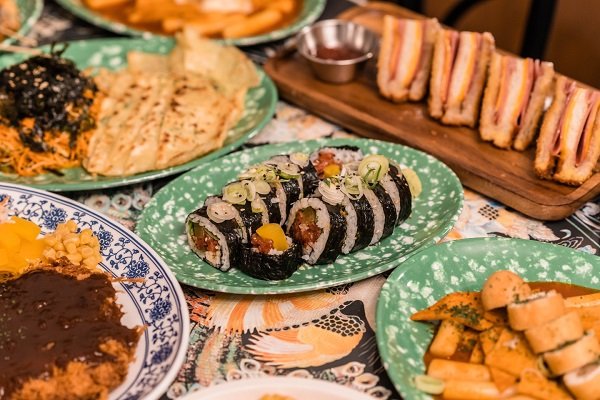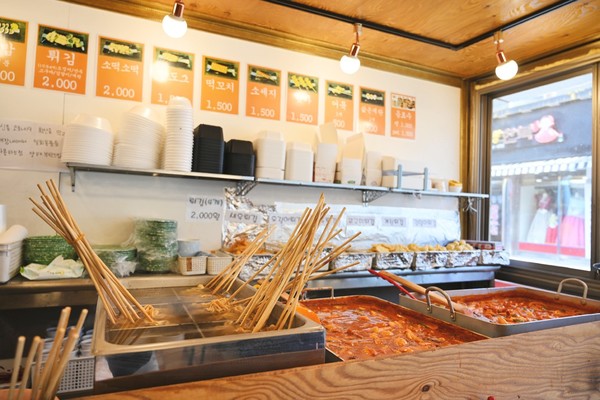Bunsik (분식, 粉食)

A variety of Bunsik(s)
I am aware this may sound incredibly stereotypical, as an American, but I miss fast food. Or rather, I miss the meaning that fast food held in my life. Fast food restaurants are not known for their high quality cuisine, excellent customer service, and consistently satisfying dining experience. Many are rightfully critical of the dubious ingredients and questionable sanitation. However, if one is tight on money, craving a late night snack, and is not in a state to cook for themselves, fast food is always at one’s fingertips, burgers and fries tucked away under their iridescent heating lamps waiting for the next customer to wander in. When I am at my lowest, McDonalds is there to save me, its golden arches illuminating the stairway to heaven.
That is why my first encounter with Seoul was so shocking. There are plenty of local and international fast food chains, but their place within Korea’s dining industry is drastically different from America. Fast food is still a quick and convenient option, but undercutting it is a style of food not often represented in discussions on Korean cuisine: bunsik.
Bunsikjip refers to a group of a type of restaurant that sells simple and cheap dishes, such as noodles, dumplings, and types of bread. Although the etymology of bunsik refers specifically to foods made of flour, such as tteokbokki or ramyeon, it now encompasses kimbap, sundae, eomuk, and more. One can think of it as a traditional Korean version of fast food. It is cheap, easy to eat, and available on every street corner.
It is difficult to describe the beginnings of bunsik as it includes various foods, all of which Koreans have been consuming for decades. Mabokrim Tteokbokki claims to be the first restaurant to boil ddeok in a gochujang sauce, inventing the now iconic tteokbokki as recently as 1953. Meanwhile, eomuk have been eaten in East Asia since the 3rd century. While the general origins of bunsik are vague, bunsik established itself as a staple food during the mid twentieth century.
Following the Korean War, the Republic of Korea was plunged into economic turmoil that affected the lives and livelihoods of millions of people, and this was only worsened by national food insecurity that took place over the following decades. In addition to the primary rice crop harvested at the time having a relatively low yield, President Park Chunghee’s administration encouraged rice exports as a way to bring in more foreign currency into Korea’s economy, stabilizing it. This resulted in rice, the staple food in every Korean’s diet, becoming increasingly scarce. The Korean government in turn promoted bunsik due to flour’s accessibility and affordability, going as far as banning rice sales on certain days in order to prevent a larger hunger crisis or famine.
While economic factors were certainly at the center of bunsik’s spread throughout the country, there is undeniably a cultural aspect to its popularity. As I stated, bunsikjip are ubiquitous in Seoul, always providing cheap, ready-made food to the city’s millions of residents. Their hours also tend to be late, meaning students spending their nights studying at hagwons, office workers doing overtime, and friends coming home after a night out will always be able to find a meal. Munbanggu also cemented bunsik in the hearts of people across generations. Munbanggu were a type of personal stationery stores often located around elementary schools for students to visit after school. However, instead of stationery, they are most famous for their tteokbokki that would serve as an after school snack for students.
Bunsik’s popularity is not limited to Korea. Following the Hallyu wave, many Korean foods, such as kimchi and bulgogi, have gained popularity along with Korean dramas, music, and skincare. However, the popularity of certain foods varies based on their audience. While foodies and chefs have been enamored with Korea’s deep tradition of fermentation and various soups and stews, teenagers seem to be hooked on bunsik classics like tteokbokki and ramyeon. Maangchi, the most popular Korean food YouTuber, has a tteokbokki recipe video with over 14 million views, and there are many other videos with similarly high view counts. The brand Shin Ramyun has developed a reputation in America for being the best instant noodles, and Buldak Bokkeum Myun went viral for its intense spice. Foods most iconic to Korea have certainly received worldwide acclaim, but it is interesting that cheap snack foods are gaining just as much of a following.
However, bunsik is not without any downsides. The nutritional content of bunsik is next to nothing. Most dishes are a mix of refined carbohydrates and salt with little protein, fiber, or vitamins. The traditional Korean diet is relatively high in sodium, over 80% above the World Health Organization’s recommendation. However, most studies only consider the traditional Korean diet of fermented foods, stews, and rice. Young Koreans who eat bunsik frequently as part of their normal diets may consume even more.
Before coming to Korea, I had plenty of expectations on my life here. I had searched for cafes around Seoul to visit. I had asked friends for recommendations and tried to get a sense of the vibe of different neighborhoods. One thing I could have never predicted, however, is the fact that bunsik would become a central part of my life. When I go to suljip with friends, we order a plate of tteokbokki. On Saturday nights on my way home I pick up a roll of tuna kimbap and kimchi mandu. I have had plenty of difficult nights in Seoul, but no matter how tough it gets, I can always rely on bunsik to get me through the rest of the day. If I am craving a taste of home, I can always go to a local McDonalds and get a classic burger. But now bunsik has taken a place in my heart just as much as my much-adored American fast food.
Written by: Curtis Feldner
Originally from Atlanta, Georgia, USA. Currently a 4th Year undergraduate pursuing a BS in Educational Studies at University of Wisconsin-Madison. Exchange student at Korea University and intern at VANK (Voluntary Agency Network of Korea)
